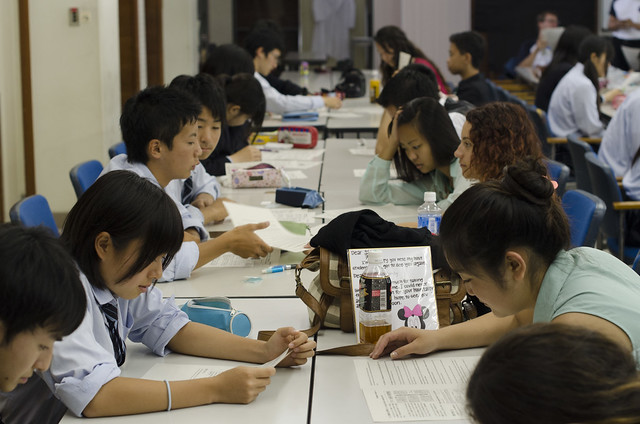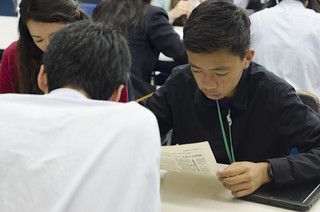The question was simple. So simple it was a tad mundane. And for the most part, the North High students considered the question so mundane that it hardly warranted a fully raised hand, merely a lazily lofted arm: two-dozen or so palms wisped like daisies made heavy with the morning dew.
But the surprise that bubbled from the Japanese students belied just how exceptional the question actually was.

And, so, Kuwabara prepped his reading class a week in advance of the North High students’ arrival, leading 3-D組 in a small discussion about the most important characteristics of a Japanese person. “When you think of what makes a Japanese person different from all other people in the world,” it was asked, “what traits come to mind?”
The students came up with two answers that were basically the flip-side of each other: 1) Japanese people are “modest,” and 2) Japanese people “lack self-confidence.” These traits, it was believed, stood in direct opposition to what the American students were going to bring to the class they would share at the end of the month.
And so, on the day of 3-D組 Reading, the class was abuzz with nervous energy, the Japanese kids exuding polite deference while the Americans, no doubt, brimmed with confidence and pride. Kuwabara passed out a packet of articles and asked the students to work together to read and interview each other with some pre-written questions in summary and analysis.
The first article was from a media conference after Yu Darvish’s first spring training appearance with the Texas Rangers. The press asked him to critique his own performance, especially noting a well-struck ball that fell just short of being a homerun. In standard Japanese-fashion he answered plainly and honestly, saying that the pitch wasn’t the best and if the batter would have just gotten a little more square it would certainly have been a homerun.
It was an unremarkable comment, in the least, except that it sparked a mini-controversy. As most fans of American baseball know, regardless of the objectivity of the assessment, the pitcher is never supposed to critique the batter. This, however, confused many of the Japanese students: such a comment is not uncommon amongst Japanese players, but this article illustrated how cultural differences can easily be misconstrued as rudeness or insult. Since many of our students only encounter foreigners as tourists in Japan, it is easy for them to read the cultural ignorance of tourists as rudeness, unaware that inter-culturally this works both ways.


The second article was written a few months later and focused on Darvish’s All-Star projections. Arriving much heralded as a top Japanese prospect, despite having only a few starts to his credit, Darvish was in the lead according to fan-votes to make an appearance in his very first All-Star Game in his freshman season. However, when asked to comment about the potential to pitch as a rookie, Darvish, flattered, responded by saying that he felt he had not yet earned such an honor.
And while the Japanese students lauded this response with fervent nods of approval, they fully expected the American students to shun it as too passive, as silly, as weak.
So, after being asked if they approved of what Darvish had said, when hand after American-hand sprouted amongst the field of heads in agreement, a gentle wave of murmurs of disbelief spread across the room like a spring breeze. 「ビックリでした!」, the Ichikashi students muttered under their breath: “Shocking.” Perhaps they were not the only ones who could appreciate humility.
Ultimately, it was a simple lesson with simple questions that lead to a simple and relatively predictable conclusion. But, as Kuwabara posits, these are questions that apparently have not yet been asked of our students. “They don’t really think about what it means to be Japanese,” he says of the kids, many of whom live in predominantly homogenous communities and so never have occasion to consider such critical questions, even the simple ones.
But one thing that I learned in my time as a youth advisor teaching hermeneutics in America is that we should never eschew simple questions merely for the sake that they are simple. In fact, many of the biggest interpretational mistakes I see arise from skipping the simple questions because those questions appear beneath the reader’s assumptions, because “advanced” readers shouldn’t have to bother with such low-standing bramble.
Rather, the root of critical thinking is in learning which questions, no matter how simple or reductive, always need to be asked. It is those simple questions that are often the hardest to answer, and often the real reason we learn to skip them is because it is more convenient to assume their rightness than to investigate their validity. But if left untended, the briar becomes a patch: we take their rightness for granted only to find after a few steps our feet tangled and our interpretations tripped. And many of our students, Kuwabara continues, take the composition of their Japaneseness for granted.
I have started working with Kuwabara to expand this assignment into a short series of such critical thinking assignments where, by using cultural texts in English (both resources in writing and the resident Foreign Language Instructors), they will be challenged to ask questions about what they think it means to be Japanese and how their critical approaches to this question affects those around them
1May be relevant:
1.For example, the lesson I am currently writing, using a Facebook exchange as “text,” discusses homogeny as a core principle of national identity and what that does to students who are wholly invested in the Japanese national identity but appear to fall outside of such “normalcy” (foreign-looking people who were born and raised in Japan, for one). How assumptions of identity through “seemingness” appear to easily qualify subscription, but cruelly alienates indiscriminately.
That day I believe I saw the sublime pass over one student's face like the revelation of the divine glow of the moon passing from behind a cloud as we watched stereotypes collapse with the lazy flick of the wrist of the American students who raised their hand in passive agreement.
Not two weeks ago at a 飲み会 I was talking to Narazaki-先生, a 二学生 history teacher at Ichikashi. He was saying, as educators, they live for these moments where the practical collection of knowledge passes from mere static facts into dynamic nodes of relation and reference for the pursuit of further knowledge. That the dates of this emperor's rule or the kanji for this ancient place, these things certainly must be memorized. But there are those rare moments when, for a student who has been desperately juggling disparate names and dates all year long, everything just falls into place like plastic shapes in the game Perfection. Connections are made and the world of history opens up like an unlocked cipher, where today is now seen through the lens of yesterday, and allows us see the possibilities of tomorrow in a whole new way.
He revels in those moments—they all revel in these moments—he said, and that is when teaching feels worth it.
And then, just like in Perfection, the bell sounds and the pieces are tossed into the air, only to fall to the floor in a jumble to be collected again next period.
Wonderful.
ReplyDeleteNicely done, really emphasizing the cultural difference between Japan and USA. I really enjoyed the last part regarding the history teacher.
ReplyDelete